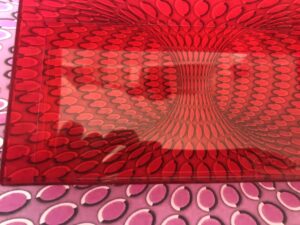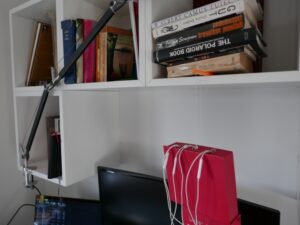Cornell Box
For the Cornell Box assignment I wanted to deepen my field of interest and create something that could serve as an installation on a bigger scale. After some reading of the book: The World of Marcel Duchamp I became intrigued by the conceptual and plastics art. Materials that are used in the plastic arts are those that can be curved: wood, stone, plastic, concrete… In this post I will take you through my creative practice and how the concept developed along the way. If you are reading through this post, I would kindly ask you for some valuable feedback.
My first task in designing a Cornell Box was to carefully make three holes in the material. I really liked the plastic box because it was transparent and I could later play with mood and change the background accordingly. Soon I was hit by an obstacle, making holes in plastic without the proper tool can be a challenging task. I have narrowed my options to use fire to mold the holes or to use driver drill tool but neither was successful as the box soon got broken after the first try of using driver drill.

Later, I used a cardboard box which was way easier for molding holes inside. My idea was to pull headphone cables through those holes in order to create a system of “inside” and “outside”. Inside of the box was constructed of six headphones, while the outside has been manipulating the environment inside the box. I think that this metaphor could map what is happening in many countries right now due to pandemic and politics that are manipulating or deciding with the society that lives within the borders (at least what is happening in Slovenia). Later I started to think about what do I want to play through those headphones? I wanted to create a musical interface that consists of my favorite songs. On a bigger scale for example an installation could represent modern audio streaming platforms but in a physical space where users wouldn’t be isolated and limited to their own space, instead they would be able to interact and form relationships, share ideas and their thoughts about the tracks listened. When I tested it how it works, I wasn’t satisfied with the output as the soundscape wasn’t really pleasing due to different music styles being mixed. At this point of the process, I have realized my deeper interest in aesthetics of sounds and decided to dedicate the space in the box to smaller elements that construct the track. In Ableton I’ve created a track for: kick, hihats and bass, which would be played from different devices into headphones but together they would form a unity. Thinking in larger scale with more headphones, this interface would enable users to choose the sounds that they liked the most and combine them in their own stereo pattern and eventually save it. This interface has some connection to Ableton’s interface where you are able to play only the selected tracks but it has been translated from the digital space into physical. When I tested this idea, I have realized that what you hear from the box if you do not put headphones in your ears is only high frequencies (hihats). This made me think of the readings for data collection class and the “god’s view”, where on the surface things seem different from what is beneath it. At the end of the creative practice, I realized that what I’ve created is also an instrument if the box is closed it can be used as a “shaker”.


Overall, I think that brainswarm technique in combination with Cornell Box has been a successful exploration of possible outputs for the topic that I am interested to develop. I would like to continue working with this project and find solutions for realizing it as my explorations continue to grow.
3 people that would be interested in my project or work in this field:
Related Posts
Leave a Reply Cancel reply
You must be logged in to post a comment.
Kat Sullivan
Adam Colestock
Helen (Chenuan) Wu
Christina Lan
Dorian Janezic
George Faya
Julia Myers
Kelsie Smith
Michael Morran
Po-Wen Shih
Liu Siyan
Fisher Yu
—
Craig Protzel
Christopher Wray
Haoqi Xia
Hayden Carey
Katherine Nicoleta Helén
Maria Maciak
Parisa Shemshaki
Sakar Pudasaini
Skyler Pierce
Steven Doughty
Yiqi Wang
—
Andrew Lazarow
Benoit Belsot
Enrique García Alcalá
Hongyi Zhang
Jay Mollica
Li Shu
Teddy (Jian) Guo
Monika Lin
Wenye Xie
Yiru Lu
